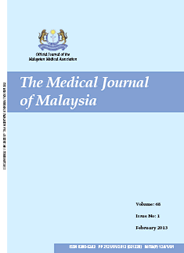MJM, Vol 70 Supplement 1 September 2015
Variation in Insulin usage between states among
Type 2 Diabetes patients attending government health clinics in Malaysia
ABSTRACT
Introduction: In 2014, the global prevalence of diabetes was estimated to be 9% among adults aged 18 years and above. In Malaysia, the prevalence of diabetes is estimated to be 15.2% (NHMS 2011). The initial treatment in most individuals with Type 2 Diabetes is an oral hypoglycemic agent (OHA). However, progression to insulin is common (28–39% incidence among older men). According to US Centers for Disease Control and Prevention, from 1997 to 2011, the number of known case diabetes for adults aged 18 years or older that take insulin, pills, or both is increased. For those taking insulin only, trends showed little or no change until 2007 and increased afterwards. The objective of the study is to describe the variation in insulin usage between states in Type 2 Diabetes patients attending government health clinics in Malaysia.
Method: This is a cross-sectional study using data from the annual National Diabetes Clinical Audit from year 2009-2014 involving all states in Malaysia. The audit is conducted by random sampling method using National Diabetes Registry (NDR) system.
Results: Generally, there was a steady growth in percentage of patients receiving insulin treatment in all states from 2009-2014. In 2014, the top 5 states with the highest percentage of T2DM patients receiving insulin were Wilayah Persekutuan Kuala Lumpur (30.87%), followed by Kelantan (30.73%), Selangor (30.4%), Negeri Sembilan (29.89%) and Terengganu (29.77%). Meanwhile WP Labuan (10.31%) and Sarawak (17.79%) had the lowest percentage of use.
Conclusion: There is a large variation in insulin usage between states in Malaysia. A further study is required to determine the factors influencing the large variation.
